Tricarballylic acid
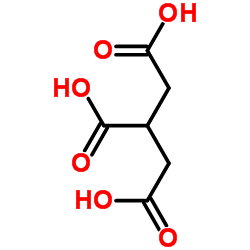
Tricarballylic acid structure
|
Common Name | Tricarballylic acid | ||
|---|---|---|---|---|
| CAS Number | 99-14-9 | Molecular Weight | 176.124 | |
| Density | 1.6±0.1 g/cm3 | Boiling Point | 266.4±20.0 °C at 760 mmHg | |
| Molecular Formula | C6H8O6 | Melting Point | 156-161 °C(lit.) | |
| MSDS | Chinese USA | Flash Point | 129.2±18.3 °C | |
| Symbol |

GHS07 |
Signal Word | Warning | |
Use of Tricarballylic acidTricarballylic acid, a conjugate acid of a tricarballylate, is a competitive inhibitor of the enzyme aconitate hydratase (aconitase; EC 4.2.1.3) with a Ki value of 0.52 mM[1]. |
| Name | tricarballylic acid |
|---|---|
| Synonym | More Synonyms |
| Description | Tricarballylic acid, a conjugate acid of a tricarballylate, is a competitive inhibitor of the enzyme aconitate hydratase (aconitase; EC 4.2.1.3) with a Ki value of 0.52 mM[1]. |
|---|---|
| Related Catalog | |
| Target |
Ki: 0.52 mM (aconitate hydratase)[1] |
| References |
| Density | 1.6±0.1 g/cm3 |
|---|---|
| Boiling Point | 266.4±20.0 °C at 760 mmHg |
| Melting Point | 156-161 °C(lit.) |
| Molecular Formula | C6H8O6 |
| Molecular Weight | 176.124 |
| Flash Point | 129.2±18.3 °C |
| Exact Mass | 176.032089 |
| PSA | 111.90000 |
| LogP | -1.33 |
| Vapour Pressure | 0.0±1.1 mmHg at 25°C |
| Index of Refraction | 1.529 |
| Water Solubility | H2O: 50 mg/mL, clear |
| Symbol |

GHS07 |
|---|---|
| Signal Word | Warning |
| Hazard Statements | H315-H319-H335 |
| Precautionary Statements | P261-P305 + P351 + P338 |
| Personal Protective Equipment | dust mask type N95 (US);Eyeshields;Gloves |
| Hazard Codes | Xi: Irritant; |
| Risk Phrases | R36/37/38 |
| Safety Phrases | S26-S36 |
| RIDADR | NONH for all modes of transport |
| WGK Germany | 3 |
| HS Code | 2917190090 |
| Precursor 9 | |
|---|---|
| DownStream 5 | |
| HS Code | 2917190090 |
|---|---|
| Summary | 2917190090 acyclic polycarboxylic acids, their anhydrides, halides, peroxides, peroxyacids and their derivatives VAT:17.0% Tax rebate rate:9.0% Supervision conditions:none MFN tariff:6.5% General tariff:30.0% |
|
Enhanced shRNA delivery and ABCG2 silencing by charge-reversible layered nanocarriers.
Small 11(8) , 952-62, (2015) Polycationic vectors have been used to deliver short hairpin RNAs (shRNAs) to knock-down genes for cancer therapies, but their inefficiency in lysosomal escape and shRNA release causes their low gene ... |
|
|
Citrate modulates lipopolysaccharide-induced monocyte inflammatory responses.
Clin. Exp. Immunol. 180 , 520-30, (2015) Citrate, a central component of cellular metabolism, is a widely used anti-coagulant due to its ability to chelate calcium. Adenosine triphosphate (ATP)-citrate lyase, which metabolizes citrate, has b... |
|
|
Reactions of atomic metal anions in the gas phase: competition between electron transfer, proton abstraction and bond activation.
J. Phys. Chem. A 115(48) , 14006-12, (2011) Bare metal anions K(-), Rb(-), Cs(-), Fe(-), Co(-), Ni(-), Cu(-), and Ag(-), generated by electrospray ionization of the corresponding oxalate or tricarballylate solutions, were allowed to react with ... |
| EINECS 202-733-3 |
| Propane 1,2,3-tricarboxylic acid |
| 3-Carboxyglutaric acid |
| Carballylic acid |
| tricarballylic acid |
| 3-Carboxypentane-1,5-dioic acid |
| MFCD00002723 |
| Propane-1,2,3-tricarboxylic acid |
| QV1YVQ1VQ |
| 1,2,3-Propanetricarboxylic acid |
| β-Carboxyglutaric acid |
 CAS#:499-12-7
CAS#:499-12-7 CAS#:149-91-7
CAS#:149-91-7 CAS#:7686-77-3
CAS#:7686-77-3 CAS#:97-65-4
CAS#:97-65-4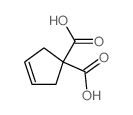 CAS#:88326-51-6
CAS#:88326-51-6 CAS#:2922-42-1
CAS#:2922-42-1 CAS#:99-67-2
CAS#:99-67-2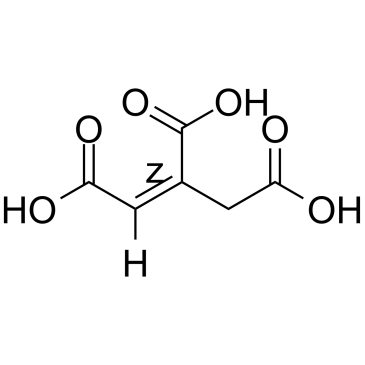 CAS#:585-84-2
CAS#:585-84-2 CAS#:5247-13-2
CAS#:5247-13-2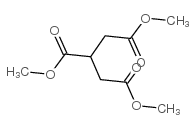 CAS#:6138-26-7
CAS#:6138-26-7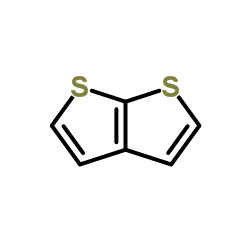 CAS#:250-84-0
CAS#:250-84-0 CAS#:77461-97-3
CAS#:77461-97-3![6a-methyl-3a,4-dihydro-3H-furo[2,3-b]furan-2,5-dione structure](https://image.chemsrc.com/caspic/326/98546-44-2.png) CAS#:98546-44-2
CAS#:98546-44-2 CAS#:4756-10-9
CAS#:4756-10-9
